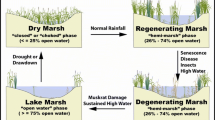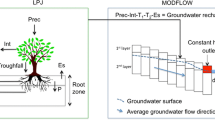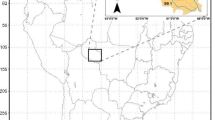Abstract
The effects of historical land-use and land-cover changes on the climate of the Swiss Plateau in the different seasons were investigated. In the 19th century, a civil engineering project was initiated to reshape the lake and river system on the Swiss Plateau in order to ban the frequent flooding during extreme weather events. The landscape modifications consisted primarily of a conversion of wetlands with extended peat soils into a highly productive agricultural landscape. Historical maps (1800–1850) served as a basis for the reconstruction of the past land use. The “Lokal-Modell” of the Consortium for Small-Scale Modelling was used to conduct eight one-month long high-resolution simulations (1.5 × 1.5 km2) with present and past landscape conditions. The modified soil and surface properties led to distinctly altered energy and moisture exchanges at the surface and as a consequence affected the local and regional climate. The climatic changes show different characteristics and magnitudes in the cold (October – March) as compared to the warm season (April – September). The landscape modifications led to an average daytime cooling between −0.12 °C (January) and −0.61 °C (April) and a night-time warming of 0.19 °C−0.34 °C. The differences in the mean monthly temperatures show a warming of 0.1 °C−0.2 °C in the cold season and a cooling of similar magnitude in most of the study area in the warm season. The modification of the radiation budget and the surface energy balance distinctly affected the convective activity in the study area in the warm season, but had only a weak effect on convectivity in the cold season. The cloud coverage in the warm season is therefore distinctly reduced compared to the past.
Similar content being viewed by others
References
Baidya Roy. S, Hurt GC, Weaver CP, Pacala SW (2003) Impact of historical land cover change on the July climate of the United States. J Geophys Res 108(D24):4793
Brown A (1999) Characterising prehistoric lowland environments using local pollen assemblages. J Quarternary Sci 14(6):585–594
CEC (1995) Wise use and conservation of wetlands. Communication from the Commission to the Council and the European Parliament. Commission of the European Communities (CEC), Brussels
Chase TN, Pielke RA, Kittel TGF, Nemani RR, Running SW (1996) The sensitivity of a general circulation model to global changes in leaf area index. J Geophys Res 101:7393–7408
Chase TN, Pielke RA, Kittel TGF, Nemani RR, Running SW (2000) Simulated impacts of historical land cover changes on global climate in northern winter. Clim Dynam 16:93–105
Chase TN, Pielke RA, Kittel TGF, Zhao M, Pitman AJ, Running SW, Nemani RR (2001) Relative climatic effects of landcover change and elvated carbon dioxide combined with aerosols: a comparison of model results and observations. J Geophys Res 106(D23):31,685–31,691
Clement R, Horn S (2001) Pre-Columbian land-use history in Costa Rica: a 3000-year record of forest clearance, agriculture and fires from Laguna Zoncho. Holocene 11(4):419–426
Cleugh HA, Raupach MR, Briggs PR, Coppin PA (2004) Regional-scale heat and water vapour fluxes in an agricultural landscape: an evaluation of CBL budget methods at oasis. Bound-Lay Meteorol 110:99–137
de Sherbinin A (2002) Land use and land cover change – a ciesin thematic guide. Center for International Earth Science Information Network, Columbia University, Palisades, NY
Eugster W, Siegrist F (2000) The influence of nocturnal CO2 advection on CO2 flux measurements. Basic Appl Ecol 1(2):177–188
Fay B, Schrodin R, Jacobsen I, Engelbart D (1997) Validation of mixing heights derived from the operational NWP models at the German Weather Service. In: S.-E. Gryning (ed): EURASAP workshop proceedings on The Determination of the Mixing Height – Current Progress and Problems pp 55–58
Frei E, Vökt U, Flückiger R, Brunner H, Schai F (1980) Bodeneignungskarte der Schweız 1:200'000. Bern: Eidg. Justiz- und Polizeidepartement, Bundesamt für Raumplanung
Fyfe R, Brown A, Rippon S (2003) Mid- to late-Holocene vegetation history of Greater Exmoor, UK: estimating the spatial extent of human-induced vegetation change. Veg Hist Archaeobot 12(4):215–232
Gobet E, Tinner W, Hochuli P, van Leeuwen J, Ammann B (2003) Middle to late holocene vegetation history of the upper Engadine (Swiss Alps): the role of man and fire. Veg Hist Archaeobot 12(3):143–163
Govindasamy B, Duffy PB, Caldeira K (2001) Land use changes and Northern Hemisphere cooling. Geophys Research Letters 28(2):291–294
Jahns S (2000) Late-glacial and Holocene woodland dynamics and land-use history of the lower Oder valley, north-eastern Germany, based on two, AMS C-14-dated, pollen profiles. Veg Hist Archaeobot 9(2):111–123
Kustas WP, Jackson TJ, Prueger JH, Hatfield JL, Anderson MC (2003) Remote sensing field experiments evaluate retrieval algorithms and land-atmosphere modeling. EOS 84(45):485–493
Loveland TR, Reed BC, Brown JF, Ohlen DO, Zhu J, Yang L, Merchant JW (2000) Development of a global land cover characteristics database and IGBP DISCover from 1-km AVHRR data. Int J Remote Sens 21(6/7):1303–1330
McNider RT, Kopp FJ (1990) Specification of the scale and magnitude of thermals used to initiate convection in cloud models. J Appl Meteorol 29:99–104
Mölders N (1999) On the effects of different flooding stages of the oder and different land-use types on the distributions of evapotranspiration, cloudiness and rainfall in the Brandenburg-Polish border area. Contr Atmos Phys 72(1):1–25
Mölders N (2000) Similarity of microclimate as simulated in response to landscapes of the 1930s and the 1980s. J Hydrometeorol 1:330–352
Ohlendorf C, Sturm M, Hausmann S (2003) Natural environmental changes and human impact reflected in sediments of a high alpine lake in Switzerland. J Paleolimnol 30(3):297–306
Pielke RA (2001) Influence of the spatial distribution of vegetation and soils on the prediction of cumulus convective rainfall. Rev Geophys 39:151–177
Pielke RA, Avissar R, Raupach M, Dolman JA, Zeng X, Denning AS (1998) Interactions between the atmosphere and terrestrial ecosystems: influcene on weather and climate. Global Change Biol 4:461–475
Pielke RA, Walko RL, Steyaert LT, Vidale PL, Liston GE, Lyons WA, Chase TN (1999) The influence of anthropogenic landscape changes on weather in South Florida. Mon Wea Rev 127:1663–1673
Poska A, Saarse L, Veski S (2004) Reflections of pre- and early-agrarian human impact in the pollen diagrams of Estonia. Palaeogeogr Palaeocl 209(1–4):37–50
Rabin, RM, Stadler S, Wetzel PJ, Stensrud DJ, Gregory M (1990) Observed effects of landscape variability on convective clouds. B Am Meteorol Soc 71:272–280
Schättler U, Doms G (1999) The interpolation program GME2LM: a user's guide. Offenbach: Deutscher Wetterdienst (DWD)
Schneider N, Eugster W (2005) Historical land use changes and mesoscale summer climate on the Swiss Plateau. J Geophys Res 110(D19102)
Schneider N, Eugster W, Schichler B (2004) The impact of historical land-use changes on the near-surface atmospheric conditions on the Swiss Plateau. Earth Interactions 8(12):1–27
Schrieber K, Stull R, Zhang Q (1996) Distributions of surface-layer buoyancy versus lifting condensation level over a heterogeneous land surface. J Atmos Sci 53(8):1086–1107
Segal M, Garratt JR, Kallos G, Pielke RA (1989) The impact of wet soil and canopy temperatures on daytime boundary-layer growth. J Atmos Sci 46(24):3673–3684
Smith EA, Hsu AY, Crosson WL, Field RT, Fritschen LJ, Gurney RJ, Kanemasu ET, Kustas WP, Nie D, Shuttleworth WJ, Stewart JB, Verma SB, Weaver HL, Wesely ML (1992) Area-averaged surface fluxes and their time-space variability over the FIFE experimental domain. J Geophys Res 97(D17):18599–18622
Stewart JB, Verma SB (1992) Comparison of surface fluxes and conductances at two contrasting sites within the FIFE area. J Geophys Res 97(D17):18623–18628
Stohlgren TJ, Chase TN, Pielke RA, Kittel TGF, Baron JS (1998) Evidence that local land use practices influence regional climate, vegetation, and stream flow patterns in adjacent natural areas. Global Change Biol 4:495–504
Stull RB (1988) Boundary layer meteorology. Dordrecht: Kluwer Academic Publishers
Venäläinen A, Rontu L, Solantie R (1999) On the influence of peatland draining on local climate. Boreal Environ Res 4:89–100
Author information
Authors and Affiliations
Corresponding author
Rights and permissions
About this article
Cite this article
Schneider, N., Eugster, W. Climatic impacts of historical wetland drainage in Switzerland. Climatic Change 80, 301–321 (2007). https://doi.org/10.1007/s10584-006-9120-8
Received:
Accepted:
Published:
Issue Date:
DOI: https://doi.org/10.1007/s10584-006-9120-8




